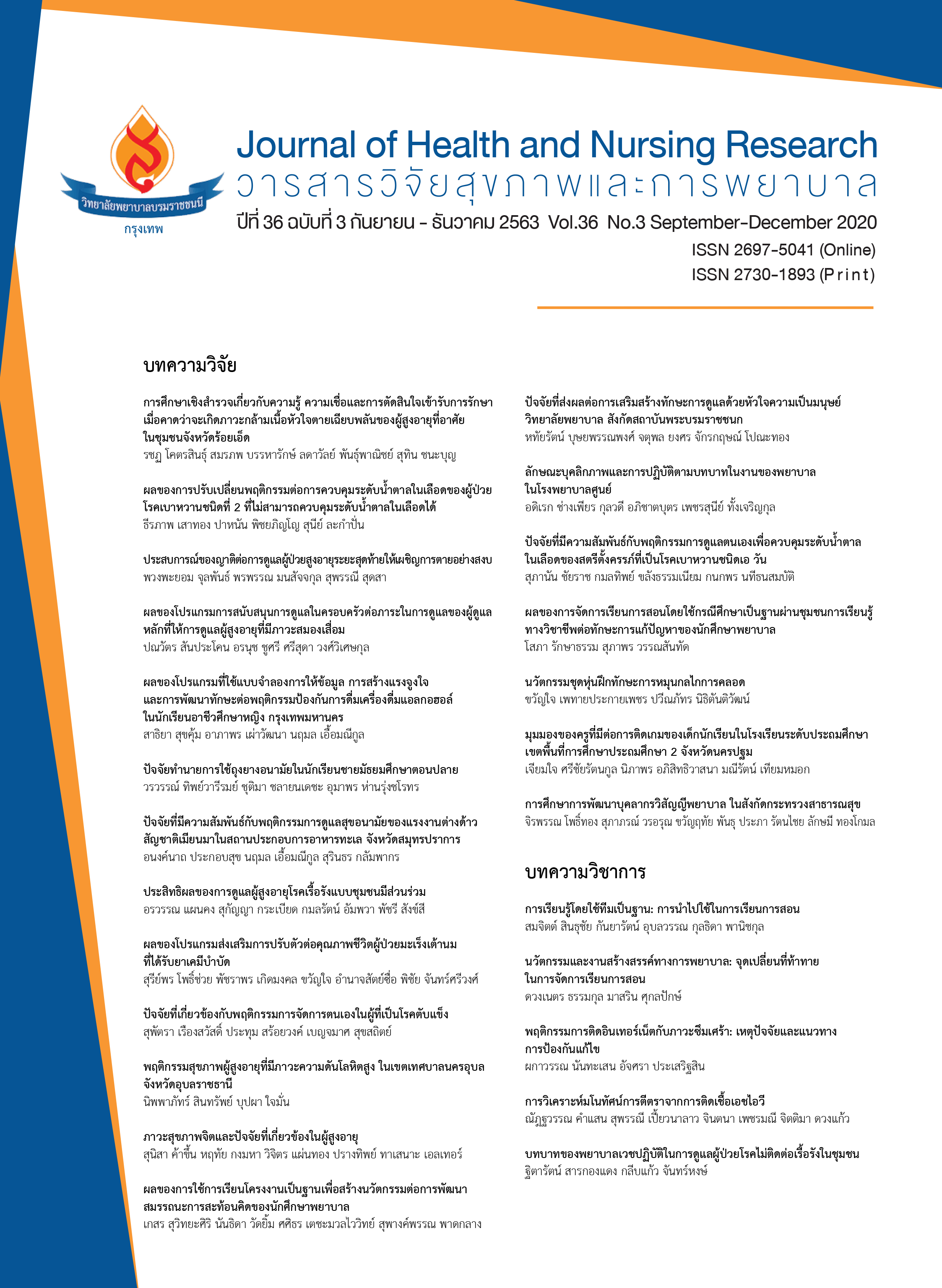ลักษณะบุคลิกภาพและการปฏิบัติตามบทบาทในงานของพยาบาลในโรงพยาบาลศูนย์
บทคัดย่อ
ลักษณะบุคลิกภาพมีความสำคัญต่อการปฏิบัติตามบทบาทในงานของพยาบาล การวิจัยเชิงพรรณนาแบบหาความสัมพันธ์ครั้งนี้มีวัตถุประสงค์เพื่อศึกษาความสัมพันธ์ระหว่างลักษณะบุคลิกภาพและการปฏิบัติตามบทบาทในงานของพยาบาลที่ปฏิบัติงานในโรงพยาบาลศูนย์ กลุ่มตัวอย่างคือพยาบาลวิชาชีพ จำนวน 413 คน คัดเลือกโดยใช้การสุ่มแบบหลายขั้นตอน เครื่องมือวิจัยประกอบด้วยแบบทดสอบลักษณะบุคลิกภาพห้าองค์ประกอบและแบบวัดการปฏิบัติตามบทบาทในงาน ค่าสัมประสิทธิ์อัลฟ่าของครอนบาคโดยรวมของเครื่องมือทั้ง 2 ฉบับเท่ากับ .85 และ .96 ตามลำดับ วิเคราะห์ข้อมูลโดยใช้สถิติเชิงพรรณนาและค่าสัมประสิทธิ์สหสัมพันธ์แบบสเปียร์แมน
ผลการวิจัยพบว่า พยาบาลมีลักษณะบุคลิกภาพแบบมีความเข้าใจผู้อื่นมากที่สุด (ร้อยละ 75.30) รองลงมาคือแบบมีความรับผิดชอบ (ร้อยละ 13.32) การปฏิบัติตามบทบาทในงานด้านความชำนาญส่วนบุคคล ในฐานะสมาชิกทีมและในฐานะสมาชิกองค์กรอยู่ในระดับมาก การปฏิบัติตามบทบาทในงานด้านการปรับตัวส่วนบุคคลและในฐานะสมาชิกทีมอยู่ในระดับมาก ส่วนในฐานะสมาชิกองค์กรอยู่ในระดับค่อนข้างมาก และการปฏิบัติตามบทบาทในงานด้านการทำงานเชิงรุกส่วนบุคคล ในฐานะสมาชิกทีมและในฐานะสมาชิกองค์กรอยู่ในระดับค่อนข้างมาก ลักษณะบุคลิกภาพแบบเปิดรับประสบการณ์ แบบมีความรับผิดชอบ แบบมีความเข้าใจผู้อื่น และแบบเปิดเผยตนเองมีความสัมพันธ์ทางบวกกับการปฏิบัติตามบทบาทในงานในด้านความชำนาญ การปรับตัว และการทำงานเชิงรุก ในขณะที่บุคลิกภาพแบบไม่มั่นคงทางอารมณ์มีความสัมพันธ์ทางลบกับการปฏิบัติตามบทบาทในงานในด้านความชำนาญ การทำงานเชิงรุก และการปรับตัวอย่างมีนัยสำคัญทางสถิติ
ผลการวิจัยครั้งนี้เป็นประโยชน์สำหรับผู้บริหารการพยาบาล โรงพยาบาลศูนย์ในการพัฒนาลักษณะบุคลิกภาพเพื่อส่งเสริมให้เกิดการปฏิบัติตามบทบาทในงานของพยาบาลที่จะทำให้การบริการมีคุณภาพและประสิทธิภาพเพิ่มขึ้นต่อไป
Downloads
เอกสารอ้างอิง
2. The Healthcare Accreditation Institute (Public Organization). Hospital and Healthcare Standards. 4thed. Nonthaburi: D one Books; 2018. (in Thai)
3. Hauschildt K, Konradt U. Self-leadership and team members' work role performance. Journal of Managerial Psychology 2012;27(5):497-517.
4. Griffin M, Neal A, Parker S. A new model of work role performance: positive behavior in uncertain and interdependent contexts. Academy of Management Journal 2007;50(2):327-47.
5. Leong CT, Rasli A. The Relationship between innovative work behavior on work role performance: An empirical study. Procedia-Social and Behavioral Sciences 2014;129:592-600.
6. Costa PT, McCrae RR. Revised NEO personality inventory (NEO-PI-R) and NEO five-factor (NEO-FFI) inventory professional manual. Odessa, Fl: PAR; 1992.
7. Neal A, Yeo G, Koy A, Xiao T. Predicting the form and direction of work role performance from the Big 5 model of personality traits. Journal of Organizational Behavior 2012;33(2):175-92.
8. Burn N, Grove S, The practice of nursing research. Conduct, Critique, and Utilization. 4thed. USA: W.B. Saunders; 2001.
9. John OP, Srivastava S. The Big Five trait taxonomy: History, measurement, and theoretical perspectives. Handbook of personality Theory and research. New York: Guilford; 1999.
10. Nuchpong N. Factors Predicting Innovative Behaviors of Nurses in Government University Hospitals [Master's Thesis]. Chiang Mai: Chiang Mai University; 2019. (in Thai).
11. Chen HY, Boore JR. Translation and back-translation in qualitative nursing research: methodological review. Journal of Clinical Nursing 2010;(1-2):234-9.
12. Kosolchuenvijit J. Caring: Central focus of humanistic care. Journal of Boromarajonani College of Nursing, Bangkok 2013;29(2):134-41. (in Thai).
13. Chiangrai Prachanukroh Hospital. Strategy plan in 10 year development [Internet]. 2020 [cited 2020 Jan 20]. Available from: http://www.harvardasia.co.th/wp-content/uploads/2019/01/Changrai-.pdf
14. Lampang hospital. Personnel development plan. Strategic map 2562-2565 [Internet]. 2020[cited 2020 Jan 19]. Available from: http://www.lph.go.th/inforlpng/ images/report/2561.pdf
15. Health Administration Division. Operating Guide: Health Services. Nonthaburi: BORN TO B Publishing; 2016. (in Thai).
16. Farida I. Factors that affect nursing. Teaching materials, course set of Nursing concept and process.7thed. Bangkok: University Press Sukhothai Thammathirat; 1986. (in Thai).
17. Pimpong S. Alternative : development of nursing personality test [doctoral thesis]. [Bangkok]: Srinakharinwirot University; 1997. (in Thai).
18. Laddawan S, Jaturaporn L, Siriboon S. A sutudy of the relationships between big five personality types and burnout in registered nurses [Master's Thesis]. [Bangkok]. Ramkhamhang university; 2005. (in Thai).
19. Anumad P, Ratchuku S. Relationships between the big five model of personality, organizational climates and career success of nurses as perceived by staff nurses in hospitals under the jurisdiction of the Ministry of Defense. Journal of The Royal Thai Army Nurses 2010;11(1):43-50. (in Thai).
20. Benner P. Form novice to expert: Excellence and power in clinical nursing practice. American Journal of Nursing 1984;82:402-7.
21. Wasinamon S. Basic Nursing, Innovation and Practice. 6thed. Bangkok: University Press Sukhothai Thammathirat; 1992. (in Thai).
22. Boonjai S. Research methodology in nursing. 4thed. Bangkok: U&I Inter Media; 2007. (in Thai).
23. Sanghon K, Thungjaroenkul P, Nantsuupawa A. Perceived Organizational Support and Proactive Work Behavior Among Registered Nurses [Master's Thesis]. Chiang Mai. Chiang mai university; 2016. (in Thai).
24. Jamjang P. The relationship between personality Social support, work characteristics, and strength in looking at the world of staff nurses Community hospital [Master's Thesis]. Bangkok:Chulalongkorn university; 2003. (in Thai).
ดาวน์โหลด
เผยแพร่แล้ว
รูปแบบการอ้างอิง
ฉบับ
ประเภทบทความ
สัญญาอนุญาต
บทความที่ได้รับการตีพิมพ์ เป็นลิขสิทธิ์ของวารสารวิจัยสุขภาพและการพยาบาล (วิทยาลัยพยาบาลบรมราชชนนี กรุงเทพ) ไม่สามารถนำไปตีพิมพ์ซ้ำในวารสารฉบับอื่น


















